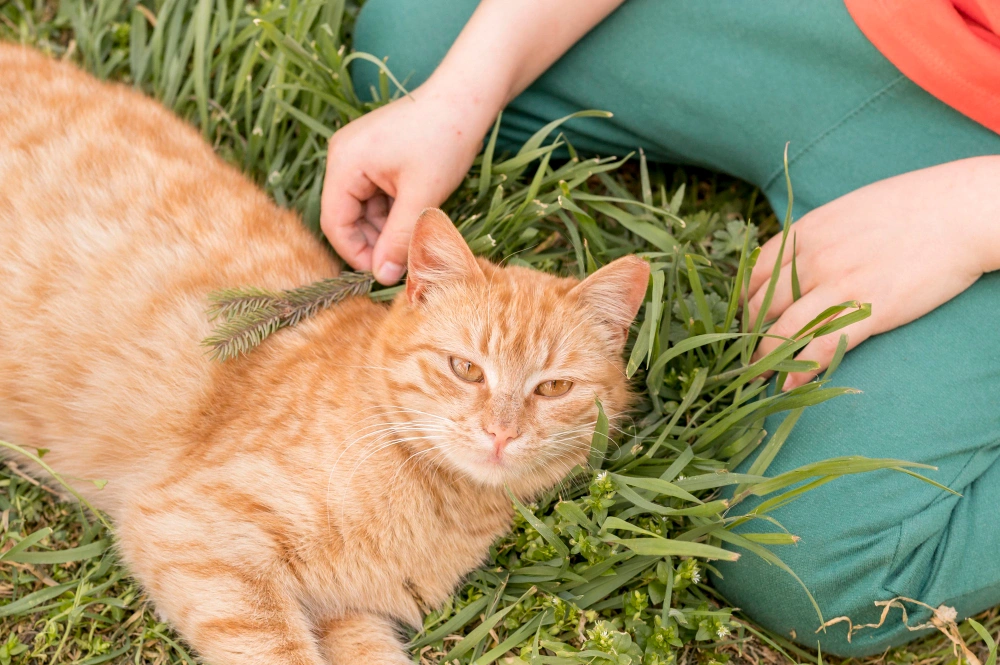Creating a beautiful, thriving garden while keeping your beloved cat safe can feel like an impossible balancing act. Whether you are dealing with a curious indoor cat who’s discovered the joys of your herb garden or an outdoor adventurer who treats your flower beds like their personal playground, cat proofing garden spaces requires thoughtful planning and eco-conscious solutions.
The good news is that you do not have to choose between a stunning garden and your cat’s safety. With the right approach to creating a cat proof garden, you can cultivate a space that is both beautiful and feline-friendly, using natural, sustainable methods that benefit both your plants and your furry family member.
This comprehensive guide will walk you through everything you need to know about cat proofing garden areas, from identifying dangerous plants to implementing safe, eco-friendly deterrents that protect your green spaces without harming your pet or the environment.
Understanding the Need for Cat Proofing Gardens
Common Garden Hazards for Cats
Before diving into solutions, it is crucial to understand why cat proofing garden spaces is so important. Gardens contain numerous potential dangers for curious felines, including toxic plants, harmful chemicals, sharp tools, and small spaces where cats can become trapped.
Many popular garden plants are toxic to cats, including lilies, azaleas, tulips, and daffodils. Even common herbs like chives and garlic can cause serious health issues if consumed. Additionally, fertilizers, pesticides, and mulches may contain chemicals that are harmful when ingested or absorbed through paw pads.
Cats’ Natural Garden Behaviors
Understanding feline behavior is key to successful cat proof garden design. Cats are naturally drawn to gardens for several reasons, soft soil makes an appealing litter box, plants provide hiding spots and entertainment, and gardens often attract birds and small animals that trigger hunting instincts.
Cats also love to dig, roll in dirt, and nibble on grass and plants. These natural behaviors are not necessarily problematic, but they become concerning when directed toward valuable or dangerous plants.
The Environmental Balance
Creating a cat proofing garden strategy that works requires finding harmony between your cat’s needs, your gardening goals, and environmental responsibility. The best solutions protect your cat while supporting local wildlife, beneficial insects, and sustainable gardening practices.
Essential Plants to Avoid in Cat-Friendly Gardens
Highly Toxic Plants
When cat proofing garden spaces, removing or relocating these extremely dangerous plants should be your first priority:
- Lilies: All varieties are extremely toxic to cats, causing kidney failure
- Azaleas and Rhododendrons: Contain toxins that affect the heart and nervous system
- Sago Palms: Every part is poisonous, with seeds being most dangerous
- Oleander: Highly toxic even in small amounts
- Foxglove: Contains cardiac glycosides that can be fatal
Moderately Toxic Garden Favorites
These popular plants should also be avoided in cat proof garden designs:
- Tulips and Daffodils: Bulbs are most toxic, causing digestive upset
- Hydrangeas: Can cause vomiting and diarrhea
- Morning Glory: Seeds are particularly dangerous
- Iris: Roots and rhizomes pose the greatest risk
- Chrysanthemums: Contain compounds toxic to cats
Herbs and Vegetables to Relocate
Even edible plants can pose risks when cat proofing garden areas:
- Chives, Garlic, and Onions: Can cause anemia in cats
- Rhubarb: Leaves contain toxic oxalates
- Tomato Plants: Green parts and stems are problematic
- Potato Plants: Green parts contain solanine
Cat-Safe Plants for Beautiful Gardens
Feline-Friendly Flowers
Creating a stunning cat proof garden does not mean sacrificing beauty. These gorgeous flowers are safe for curious cats:
- Sunflowers: Bright, cheerful, and completely safe
- Zinnias: Colorful annual flowers that cats can safely investigate
- Snapdragons: Provide vertical interest without toxicity concerns
- Marigolds: Natural pest deterrents that are cat-safe
- Petunias: Beautiful cascading flowers perfect for containers
Safe Herbs for Culinary Gardens
When cat proofing garden herb sections, choose these cat-friendly options:
- Basil: Safe and aromatic, though some cats may nibble
- Cilantro: Generally safe in small quantities
- Dill: Cat-safe and attracts beneficial insects
- Parsley: Safe for cats and useful for cooking
- Rosemary: Hardy herb that’s safe for felines
Cat-Attracting Plants (The Good Kind)
Some plants actually benefit cat proof garden design by providing safe entertainment:
- Cat Grass: Provides safe greens for indoor cats
- Catnip: Obviously a feline favorite
- Cat Mint: Similar to catnip but less intense
- Spider Plants: Safe and interesting for cats to investigate
- Wheatgrass: Healthy option for cats who like to graze
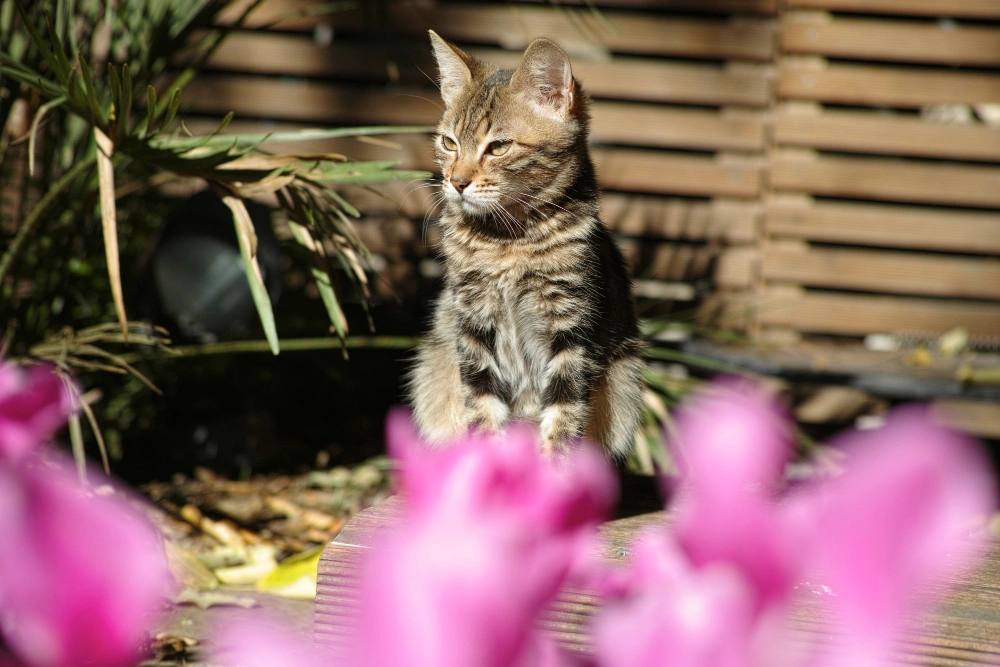
Physical Barriers and Deterrents
Natural Fencing Solutions
Effective cat proofing garden often requires physical barriers that blend seamlessly with your landscape design:
Decorative Fencing: Low decorative fences can protect specific garden beds while maintaining visual appeal. Choose bamboo, willow, or recycled plastic options for eco-friendly solutions.
Plant Barriers: Dense, thorny shrubs like roses or barberry can create natural barriers. Ensure chosen plants are non-toxic and won’t harm cats who might brush against them.
Raised Beds: Elevating planting areas makes them less accessible while improving drainage and soil quality. Use sustainable materials like reclaimed wood or recycled plastic lumber.
Ground Cover Deterrents
Strategic ground covers can make areas less appealing for cat proof garden purposes:
Mulch Selection: Avoid cocoa mulch, which is toxic to cats. Instead, use cat-safe options like shredded bark, straw, or newspaper. Some cats dislike certain textures, so experiment with different materials.
Stone and Gravel: Decorative stones or gravel create surfaces many cats prefer to avoid. Choose smooth options that won’t hurt paws, and ensure proper drainage to prevent waterlogging.
Plant Density: Dense plantings leave little room for cats to dig or use as litter areas. Ground-hugging plants like thyme or creeping phlox can effectively cover soil while adding beauty.
Eco-Friendly Deterrent Methods
Natural Scent Deterrents
When cat proofing garden areas, natural scents often prove more effective and environmentally friendly than commercial repellents:
Citrus Peels: Fresh orange, lemon, or grapefruit peels scattered around plants can deter cats. Replace regularly and compost old peels for zero waste.
Coffee Grounds: Used coffee grounds provide nitrogen for plants while creating a texture and scent many cats dislike. Source grounds from local cafes for a sustainable solution.
Essential Oil Sprays: Diluted peppermint, eucalyptus, or citronella oils can be effective. Always ensure proper dilution and avoid direct application to plants cats might nibble.
Water-Based Deterrents
Strategic water features can support cat proof garden goals while benefiting the ecosystem:
Motion-Activated Sprinklers: These devices startle cats without causing harm, while providing beneficial irrigation for plants. Solar-powered options reduce environmental impact.
Water Features: Strategically placed fountains or water gardens can deter cats from certain areas while attracting beneficial wildlife and creating peaceful ambiance.
Texture Modifications
Many cats dislike certain textures, making this an effective cat proofing garden strategy:
Chicken Wire: Lay flat over soil and allow plants to grow through. Choose galvanized options for longevity, and remove once plants are established.
Pine Cones: Scattered pine cones create an uncomfortable walking surface for cats while adding natural texture to garden beds.
Aluminum Foil: Temporary solution that many cats dislike. Use sparingly and remove once other deterrents take effect.
Creating Designated Cat Areas
Cat Garden Zones
Successful cat proof garden design often includes designated areas where cats are welcome:
Sandbox Areas: Create dedicated digging zones filled with sand or fine mulch. Place these away from valuable plants and maintain regularly.
Cat Grass Plots: Designate areas for cat-friendly plants like oat grass, wheat grass, or specialized cat grass blends. This satisfies cats’ need to graze while protecting other plants.
Sunny Lounging Spots: Cats love warm, sunny areas for napping. Create comfortable spots with cat-safe ground covers or outdoor cat furniture.
Enrichment Features
Incorporate features that satisfy cat’s natural behaviors while supporting cat proofing garden goals:
Scratching Posts: Weather-resistant outdoor scratching posts can redirect destructive behavior away from trees and garden structures.
Climbing Structures: Cat-friendly climbing areas satisfy vertical exploration needs while keeping cats away from delicate plants.
Hiding Spots: Dense, cat-safe shrubs or purpose-built shelters provide security and entertainment.
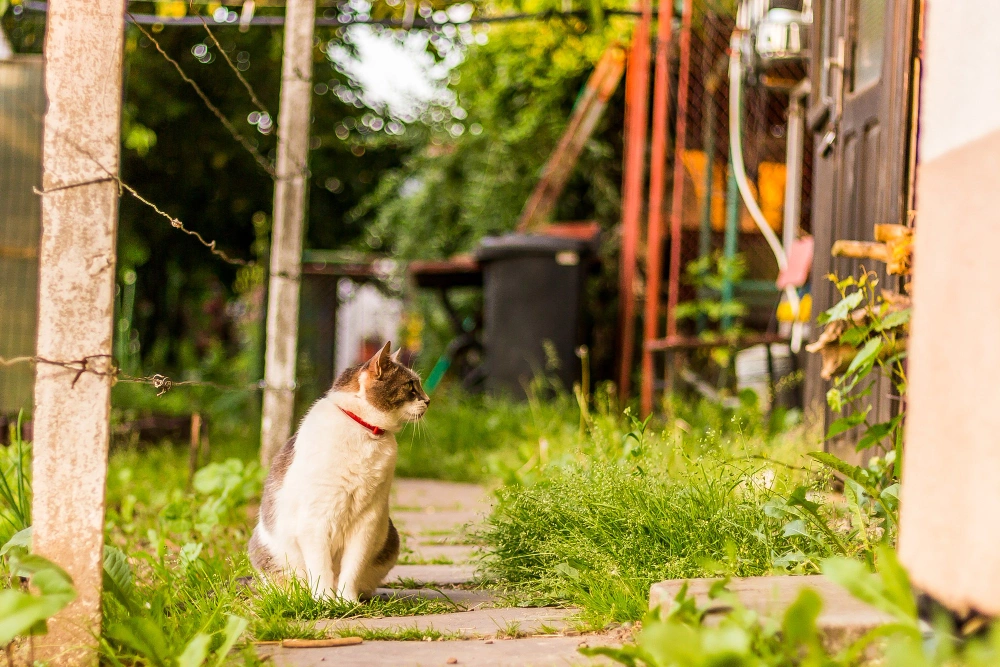
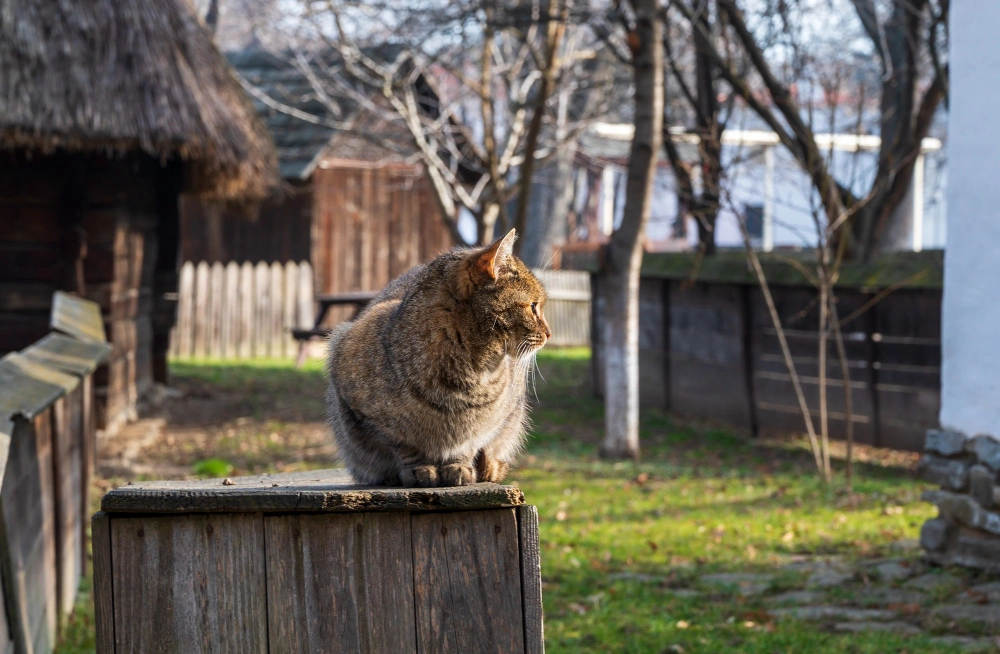
Seasonal Cat Proofing Considerations
Spring Garden Preparation
Spring presents unique challenges for cat proofing garden spaces:
Bulb Protection: Cover newly planted bulbs with wire mesh until plants establish. Remove mesh as plants grow to prevent entanglement.
Seed Starting Safety: If starting seeds indoors, ensure all materials are cat-safe and secure growing areas from curious paws.
Tool Storage: Organize garden tools in secure storage to prevent injuries. Sharp tools and small items pose particular risks.
Summer Maintenance
Hot weather creates additional cat proof garden considerations:
Shade Requirements: Ensure cats have access to shaded areas, especially if they spend time outdoors. Consider installing shade sails or planting strategic shade trees.
Water Access: Provide fresh water sources for cats, which may also benefit garden wildlife. Clean and refill regularly to prevent bacterial growth.
Heat-Loving Plant Safety: Research summer annuals for toxicity before planting, as cats may be more likely to seek shade among dense plantings.
Fall and Winter Preparations
Cooler months require different cat proofing garden approaches:
Leaf Management: Rake and compost leaves that might hide dangerous items or create slippery surfaces where cats could be injured.
Plant Protection: Cover tender plants with cat-safe materials like burlap rather than plastic, which can pose suffocation risks.
Ice Prevention: Ensure pathways remain safe for cats by using pet-safe ice melt products or providing traction with sand.
Indoor Plant Safety
Houseplant Selection
Cat proofing garden concepts extend to indoor spaces where many people grow plants:
Choose cat-safe options like spider plants, Boston ferns, African violets, and certain palms. Research each plant thoroughly before bringing it indoors.
Container Gardening
Indoor herb and vegetable gardens require special attention:
Elevated Containers: Place containers out of cat’s reach, or use hanging planters for trailing varieties.
Protective Barriers: Small decorative fences around pots can prevent digging while maintaining visual appeal.
Safe Growing Mediums: Avoid perlite and vermiculite, which can be harmful if ingested. Use organic potting soils without chemical additives.
Long-term Garden Planning
Sustainable Design Principles
Effective cat proof garden design considers long-term sustainability:
Native Plant Selection: Native plants typically require less maintenance and support local ecosystems while often being more resistant to pet damage.
Perennial Focus: Perennial plants establish strong root systems that withstand pet traffic better than annuals, reducing replanting needs.
Wildlife Balance: Design gardens that support beneficial wildlife while managing potential conflicts with outdoor cats.
Ongoing Maintenance
Successful cat proofing garden requires consistent attention:
Regular Plant Inspections: Monitor plants for damage, disease, or safety concerns. Replace problematic plants promptly.
Deterrent Maintenance: Refresh natural deterrents regularly, and adjust strategies based on effectiveness and seasonal changes.
Safety Updates: Stay informed about new plant toxicity information and adjust garden design accordingly.
Working with Professional Gardeners
Communication Strategies
When hiring garden services, ensure they understand cat proof garden requirements:
Clearly communicate your cat safety priorities and provide lists of acceptable and prohibited plants and chemicals.
Chemical Alternatives
Request organic, pet-safe alternatives for common garden treatments:
Organic Fertilizers: Compost, bone meal, and other organic options provide nutrition without chemical risks.
Natural Pest Control: Beneficial insects, companion planting, and organic sprays can manage pests without endangering cats.
Weed Management: Hand weeding, mulching, and organic herbicides provide safer alternatives to chemical treatments.
Emergency Preparedness
Plant Poisoning Response
Despite careful cat proofing garden efforts, accidents can happen:
Recognition Signs: Learn symptoms of plant poisoning including vomiting, diarrhea, lethargy, difficulty breathing, and behavioral changes.
Emergency Contacts: Keep veterinary emergency numbers readily available, including after-hours and poison control contacts.
Documentation: Maintain records of all plants in your garden, including scientific names, to aid veterinary treatment if needed.
First Aid Basics
Safe Plant Removal: If you catch your cat eating a potentially harmful plant, gently remove any remaining plant material from their mouth.
Do Not Induce Vomiting: Unless specifically instructed by a veterinarian, avoid inducing vomiting as some substances can cause additional damage.
Transport Safely: Use a secure carrier when transporting cats to veterinary care, and bring plant samples if possible.
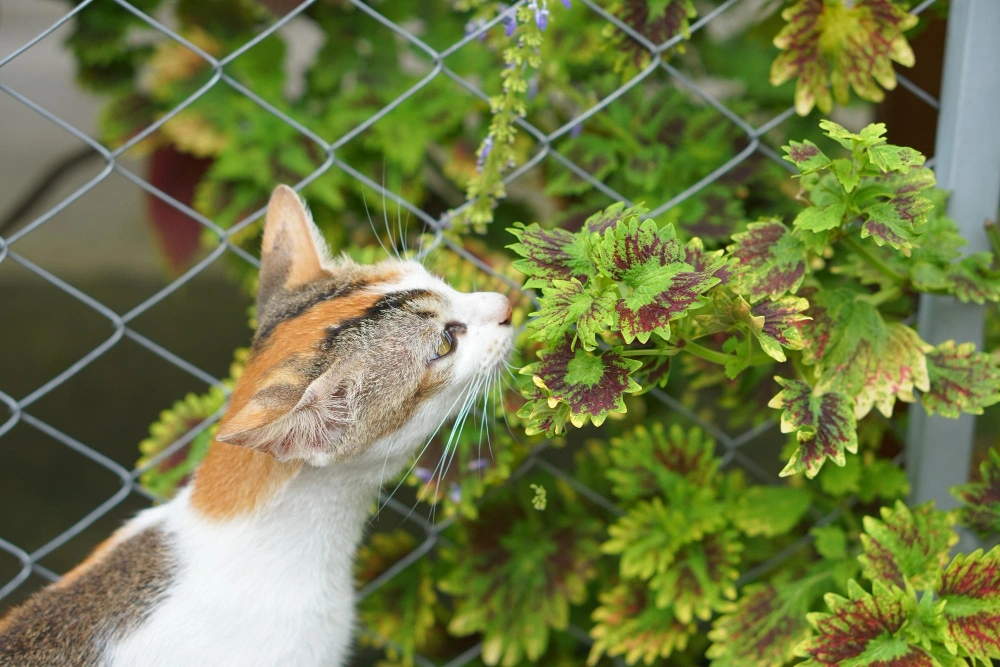
Frequently Asked Questions
Q: What are the most dangerous garden plants for cats?
The most toxic plants for cats include all varieties of lilies (which can cause fatal kidney failure), azaleas, oleander, sago palms, and foxglove. Even small amounts of these plants can be life-threatening, so they should be completely avoided in cat-accessible areas.
Q: Can I use coffee grounds to deter cats from my garden safely?
Yes, used coffee grounds are generally safe and effective cat deterrents when used properly. They provide nitrogen for plants while creating a texture most cats dislike. However, avoid using grounds from flavored coffees or those containing chocolate, and replace regularly to prevent mold growth.
Q: How can I create a beautiful garden that’s completely cat-safe?
Focus on cat-safe flowers like sunflowers, zinnias, and snapdragons, combined with safe herbs like basil and dill. Use physical barriers like decorative fencing for sensitive areas, and create designated cat zones with cat grass and comfortable lounging spots. This approach maintains beauty while ensuring safety.
Q: Are natural pest control methods safe for cats?
Many natural pest control methods are cat-safe, including beneficial insects, companion planting, and organic sprays made from ingredients like neem oil or soap. However, always research specific products and methods, as “natural” doesn’t automatically mean safe for cats. Avoid diatomaceous earth in areas cats frequent, as it can irritate respiratory systems.
Q: What should I do if my cat has eaten a potentially toxic plant?
Contact your veterinarian or pet poison control immediately. Don’t wait for symptoms to appear, as early treatment is crucial. Remove any remaining plant material from your cat’s mouth if possible, but don’t induce vomiting unless instructed by a professional. Bring plant samples to aid identification and treatment.
Final Thoughts
Creating a cat proof garden does not mean sacrificing beauty, productivity, or environmental responsibility. With thoughtful planning, eco-friendly materials, and strategic design choices, you can cultivate outdoor spaces that delight both you and your feline companion while supporting local ecosystems and sustainable gardening practices.
The key to successful cat proofing garden lies in understanding your cat’s behavior, choosing appropriate plants and materials, and implementing layered deterrent strategies that work with nature rather than against it. By focusing on prevention, providing appropriate alternatives, and maintaining vigilance, you can create gardens that are both stunning and safe.
Remember that every cat is different, and what works in one garden may need adjustment in another. Be patient with the process, willing to experiment with different approaches, and always prioritize your cat’s safety over aesthetic preferences. The reward, a thriving garden and a healthy, happy cat, makes the effort worthwhile.
As you implement these cat proofing garden strategies, you are not just protecting your pet; you are contributing to more responsible, sustainable pet ownership that benefits animals, plants, and the environment. This holistic approach to garden design represents the future of eco-conscious pet care, where the needs of our beloved companions and our planet work in harmony.
Citation
ProtectaPet. (n.d.). ProtectaPet Review: Buggi, Lulu & Polly Explore their Beautiful & Safe Cat Garden [Video]. ProtectaPet. https://protectapet.com/pages/how-to-keep-cat-in-garden
Katzecure | Cat proof your garden without compromising the aesthetics. (n.d.). https://katzecure.com/
Catproof Garden. (n.d.). Catproof gardens. https://www.catproofgardens.eu/en

